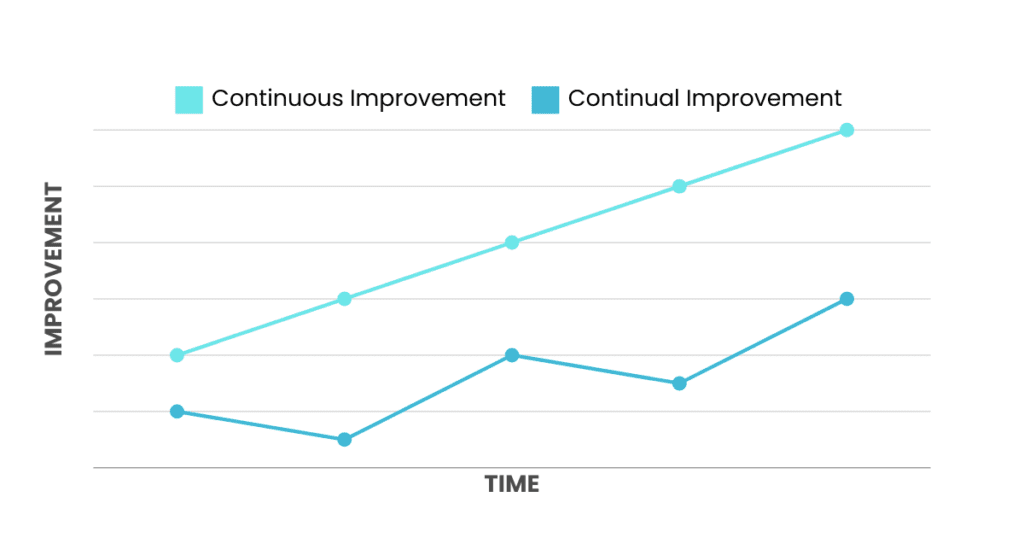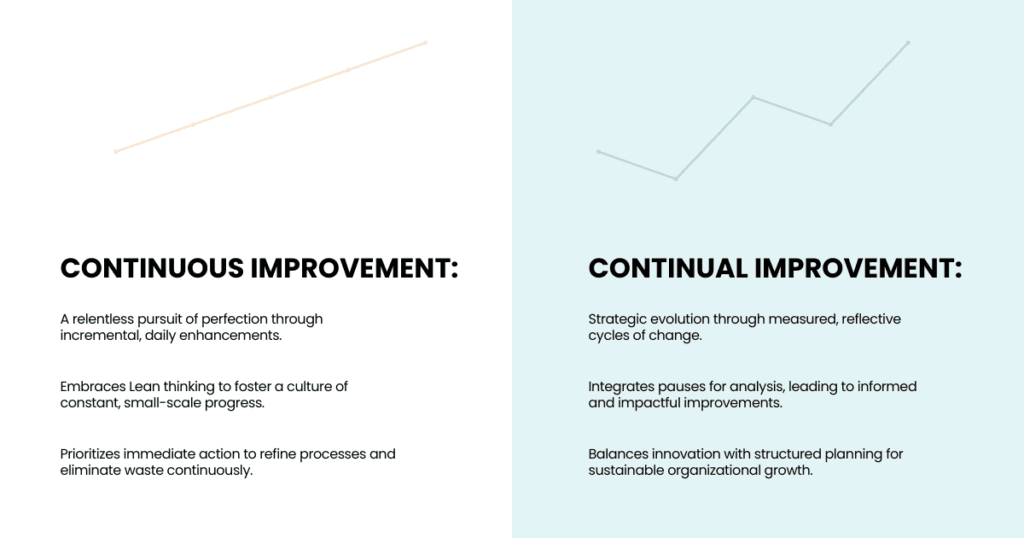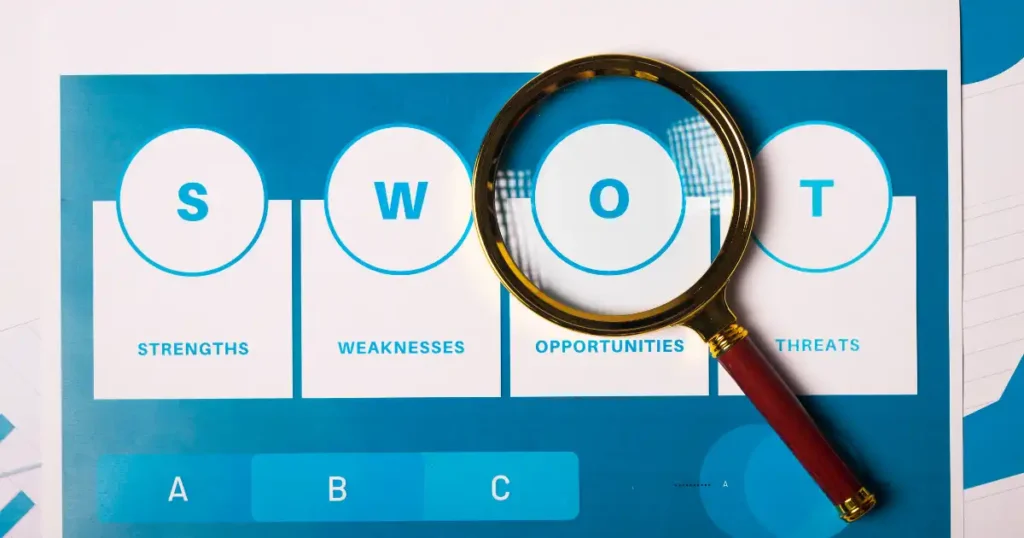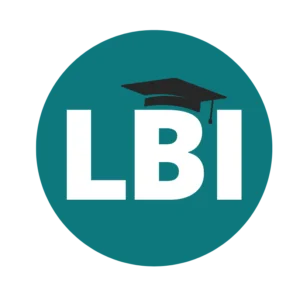Table of Contents
Introduction
In the realm of business improvement, two philosophies stand out for their impact on organizational growth and efficiency: continuous improvement and continual improvement. While they may sound similar, each approach has distinct characteristics that can significantly influence a company’s journey towards excellence.
Continuous improvement is an unceasing endeavour, a relentless pursuit of betterment without interruption. It’s akin to the steady growth of a tree, reaching higher day by day. On the other hand, continual improvement is characterized by its rhythmic nature, akin to the ebb and flow of tides, where periods of intense improvement are followed by phases of reflection and assessment.
Understanding the nuances between these two is not just academic; it’s a practical necessity for any business leader. The choice between continuous and continual improvement can shape the strategies, tools, and cultural practices within an organization, ultimately impacting its ability to adapt and thrive in a competitive landscape.
This article will delve into the definitions and basic concepts of both continuous and continual improvement, explore their historical context and origins, and examine the theoretical frameworks that underpin them. We will look at practical applications in business, compare and contrast the two approaches, and discuss their respective advantages and disadvantages. Finally, we will provide guidance on choosing the right approach for your organization, culminating in a call to action for businesses to evaluate and integrate these strategies for optimal results.
Definitions and Basic Concepts

Continuous Improvement
At its core, continuous improvement is the strategic, uninterrupted pursuit of enhancing processes, products, and services. It’s a commitment to incremental betterment, where the aim is to make small, regular changes rather than waiting for a significant overhaul.
Key Characteristics:
- Ongoing: The process is perpetual, with no defined end point. It’s about building a culture where improvement is part of the daily routine.
- Relentless: There’s a persistent effort to refine every aspect of the organization, from the smallest task to the largest strategic initiative.
- Lean Principles: Continuous improvement is often intertwined with Lean principles, particularly Kaizen—a philosophy that focuses on making small, regular changes that collectively lead to significant improvements.
Examples and Analogies: Imagine a plant that grows steadily, each day adding a bit to its height, expanding its roots, and strengthening its branches. This is akin to continuous improvement, where the growth is constant and visible over time. Just as a gardener nurtures a plant with regular care, an organization fosters its growth through continuous, incremental enhancements.
Continual Improvement
Definition: Continual improvement is a methodical approach to enhancing processes, systems, and outcomes with deliberate intervals for pause, assessment, and reflection. It’s a cyclical process that values the strategic timing of improvements as much as the improvements themselves.
Key Characteristics:
- Cyclical: The process is characterized by its rhythmic nature, where improvements are made in waves or cycles.
- Phase-Based: Each cycle includes distinct phases of planning, execution, evaluation, and refinement.
- Evaluation and Planning: Critical to this approach is the incorporation of regular evaluation and planning phases, allowing for informed decisions based on data and feedback.
Examples and Analogies: Consider the snooze function of an alarm clock. After the alarm rings, you have a brief pause before it sounds again. This interval allows you to assess whether you’re ready to wake up or need a few more minutes of rest. Similarly, continual improvement involves periods of intense activity followed by pauses for evaluation and planning, ensuring that each cycle of improvement is as effective as possible.
Another analogy is the process of seasonal crop improvement. Farmers plant crops, nurture them, and then harvest. After the harvest, they assess the yield, plan for the next season, and make improvements based on their findings. This cycle of planting, nurturing, harvesting, and improving mirrors the continual improvement process, where each phase is distinct and contributes to the overall enhancement over time.
Historical Context and Origins
The concepts of continuous and continual improvement are deeply rooted in the history of quality management. These terms originated from a need to enhance quality and efficiency in manufacturing processes and have since evolved into fundamental principles of business management.
Origins of the Terms in Quality Management: The journey of these concepts began with the recognition of quality as a critical factor in production. The systematic approach to improving quality through statistical methods was pioneered by figures such as Walter Shewhart in the early 20th century. His work laid the groundwork for what would become known as continuous and continual improvement within quality management systems.
Contributions from Key Figures like Dr. W. Edwards Deming: Dr. W. Edwards Deming, often hailed as the father of modern quality management, played a pivotal role in shaping these concepts. His philosophy emphasized the importance of quality control and continuous improvement in production processes. Deming’s methods were instrumental in Japan’s post-war economic recovery and the subsequent global success of Japanese firms. He introduced the Plan-Do-Check-Act (PDCA) cycle, which became a cornerstone of continuous improvement practices.
Evolution of the Concepts Through Standards like ISO 9001 and ISO 14001: The formalization of continuous and continual improvement principles came with the development of international standards. ISO 9001, first published in 1987, provided a framework for quality management systems, focusing on meeting customer requirements and enhancing customer satisfaction. ISO 14001, introduced in 1996, extended these principles to environmental management, helping organizations minimize their environmental footprint while maintaining efficiency.
These standards have undergone several revisions to adapt to the changing business landscape, with the latest versions emphasizing a greater focus on risk management and integration into business strategy. The evolution of ISO 9001 and ISO 14001 reflects the ongoing commitment to improvement and excellence in quality and environmental management practices worldwide.
Theoretical Frameworks and Methodologies

Plan-Do-Check-Act (PDCA) Cycle
The PDCA cycle is a foundational element in the practices of both continuous and continual improvement. Conceived by quality management pioneers and popularized by Dr. W. Edwards Deming, the PDCA cycle is a systematic series of steps for achieving quality control and continuous improvement.
Explanation of the PDCA Cycle: The PDCA cycle consists of four iterative steps:
- Plan: Identify an opportunity and formulate a plan for change.
- Do: Execute the plan on a small level to evaluate its impact.
- Check: Evaluate the results of the test and analyze the data.
- Act: Based on the analysis, take action to standardize the improvement or begin the cycle again with a revised plan.
This cycle is a project planning tool that encourages a methodical approach to making changes and ensuring those changes produce the desired effect.
Application in Both Continuous and Continual Improvement Contexts: In a continuous improvement context, the PDCA cycle is used relentlessly, with each completion leading immediately into the next cycle. This reflects the ongoing nature of continuous improvement, where changes are made consistently over time without significant pauses.
In a continual improvement setting, the PDCA cycle aligns with the cyclical nature of the approach. Each “Act” phase is followed by a pause and assessment before the next “Plan” phase begins. This allows for reflection and strategic planning after each cycle, ensuring that improvements are thoughtful and data-driven.
The PDCA cycle’s versatility makes it a powerful tool for both approaches, providing a structured methodology for implementing and managing change effectively.
Checkout our PDCA online course : Plan, Do, Check, Act (PDCA) Certification Course
Kaizen and Lean Principles
Kaizen as a Method of Continuous Improvement
Kaizen, a Japanese term meaning “change for the better,” is a philosophy that embodies the concept of continuous improvement. It is about fostering a culture where small, incremental changes regularly create significant impacts over time. Kaizen encourages all employees, from top management to frontline workers, to contribute to everyday improvements, knowing that many tiny enhancements can lead to substantial results.
The history of Kaizen dates back to post-World War II Japan, where it played a crucial role in the country’s economic reform. The methodology was notably implemented by the Toyota Motor Corporation, leading to higher product quality and worker productivity. Masaaki Imai, considered the Father of Kaizen, introduced it as a systematic management methodology, emphasizing the need for self-discipline and commitment to continuous improvement.
Lean Manufacturing and Its Relationship with Continuous Improvement
Lean manufacturing, derived from the Toyota Production System, is a management philosophy that aims to maximize customer value while minimizing waste. It is an approach that seeks to optimize processes by using fewer resources and focusing on what is essential to meet customer demands. Lean manufacturing is characterized by its emphasis on operational efficiency and continuous improvement, aiming to create high-quality products and respond promptly and flexibly to market changes.
Continuous improvement is a core aspect of Lean management principles. It is the vehicle that drives a company towards efficiency, with the belief that any process can be improved, even if it is already working well. Lean manufacturing relies on continuous improvement methodologies because it believes that there is always room for improvement—things can always get more efficient. This mindset shift is necessary throughout the organization, placing the customer at the centre of all decisions and fostering a culture of continuous improvement.
Other Methodologies
Six Sigma
Six Sigma is a disciplined, data-driven approach for eliminating defects in any process, from manufacturing to transactional and from product to service. Developed at Motorola in 1986, Six Sigma’s goal is to improve the quality of process outputs by identifying and removing the causes of defects and minimizing variability in manufacturing and business processes.
The methodology uses a collection of quality management methods, mainly empirical, and statistical methods, and creates a special infrastructure of people within the organization who are experts in these methods. Each Six Sigma project carried out within an organization follows a defined sequence of steps and has quantified financial targets (cost reduction or profit increase).
A3 Reports
A3 Reports is a tool developed by Toyota as part of their problem-solving process. An A3 Report is typically a structured template that helps teams capture the essential details of a problem-solving effort on a single sheet of paper. The name “A3” refers to the size of the paper (11×17 inches), which is used to document the problem, analysis, corrective actions, and action plan.
The A3 process is a way to look at business problems that need solving, and the report itself is a way to organize the findings in a clear, concise manner. It’s a method that helps a team focus on the most critical aspects of a problem, ensuring that everyone understands the issue and the proposed solution. The A3 Report is used to guide the dialogue and analysis during the “Improve” phase of the Six Sigma DMAIC (Define, Measure, Analyze, Improve, Control) process.
Both Six Sigma and A3 Reports play significant roles in improvement processes by providing structured, data-driven methods for identifying issues, analyzing root causes, and implementing solutions that lead to higher quality and efficiency in organizational processes.
Enroll now in our Continuous Improvement Certification course and take the first step towards becoming a leader in driving operational excellence. With our comprehensive online training, you’ll learn to analyze, sustain, and improve organizational performance using a variety of tools and methodologies.
Practical Applications in Business

Continuous Improvement in Practice
The concept of continuous improvement is not just theoretical; it’s a practical approach that has been successfully implemented by numerous companies across various industries. Let’s explore some case studies and examples to illustrate how continuous improvement is applied in the business world.
Case Studies and Examples:
- Toyota: The Toyota Production System (TPS) is a renowned production methodology that emphasizes efficiency, waste reduction, and continuous improvement. Toyota employs techniques such as Just-in-Time (JIT), Kaizen, Kanban, and Andon to synchronize production with customer demand, minimize inventory levels, and quickly address production issues.
- Amazon: Known for its culture of continuous innovation, Amazon engages in constant experimentation and customer-centricity. The company’s success is driven by its commitment to understanding and meeting customer needs, prioritizing long-term customer satisfaction over short-term profits.
Benefits:
- Increased Efficiency: Continuous improvement leads to streamlined processes, reducing waste and increasing productivity.
- Enhanced Quality: By focusing on incremental changes, companies can achieve higher quality in products and services.
- Employee Engagement: A culture of continuous improvement boosts employee morale and involvement, as they actively participate in the company’s growth.
Challenges:
- Sustaining Momentum: Maintaining the pace of continuous improvement can be challenging, especially when leadership changes occur.
- Resource Allocation: Allocating the necessary resources for continuous improvement initiatives can be difficult, particularly in organizations with tight budgets or competing priorities.
- Risk of Burnout: There is a risk of employee burnout if the pressure for constant improvement is not managed effectively.
These case studies and insights demonstrate that while continuous improvement offers significant benefits, it also presents challenges that require careful management. By learning from these examples, companies can better navigate the complexities of implementing continuous improvement strategies.
Continual Improvement in Practice
Continual improvement, with its strategic pauses for assessment and planning, is a practice that has been adopted by many organizations to foster sustainable growth and adaptability. Here are some case studies and insights into how companies implement continual improvement.
Case Studies and Examples:
- General Electric (GE): GE’s adoption of the Six Sigma methodology is a prime example of continual improvement in action. The company has integrated Six Sigma principles into its operations to systematically improve processes and eliminate defects, leading to significant cost savings and quality enhancements.
- Hewlett-Packard (HP): HP has utilized continual improvement through its Quality Improvement Cycle, which is based on the PDCA cycle. This approach has allowed HP to maintain high standards of quality and innovation while adapting to market changes.
Benefits:
- Gradual and Sustainable Progress: By allowing for intervals of reflection, organizations can make thoughtful changes that lead to long-term improvements.
- Increased Employee Engagement: Employees are more involved in the improvement process, as they have the opportunity to contribute ideas and see their implementation.
- Enhanced Customer Satisfaction: Regular enhancements based on customer feedback ensure that services and products continually meet or exceed expectations.
Challenges:
- Potential for Slower Progress: The cyclical nature of continual improvement can sometimes lead to slower progress compared to the more rapid pace of continuous improvement.
- Interruptions in Momentum: Pauses for assessment can disrupt the flow of operations and may require a concerted effort to regain momentum.
- Resource Allocation: Similar to continuous improvement, allocating resources for continual improvement initiatives can be challenging, especially when balancing them with day-to-day operations.
These examples and considerations highlight the practicality of continual improvement in business settings. While it offers numerous benefits, it also presents unique challenges that organizations must navigate to successfully implement this approach.
Comparing Continuous Improvement vs. Continual Improvement

Similarities
Despite their differences, continuous and continual improvement share several fundamental goals and prerequisites that are vital for their success in any organizational setting.
Shared Goals:
- Improving Quality: Both approaches aim to elevate the quality of processes, products, and services. They strive to reduce errors, enhance customer satisfaction, and achieve excellence in all operational facets.
- Enhancing Efficiency: Efficiency is a key target; by streamlining operations and reducing waste, both continuous and continual improvement contribute to more effective and leaner business practices.
Organizational Commitment and Cultural Alignment:
- Commitment: Successful implementation of either approach requires unwavering commitment from all levels of the organization, from top management to frontline employees.
- Cultural Alignment: Both approaches necessitate a culture that supports improvement initiatives—a culture where change is embraced, and everyone is encouraged to contribute to the organization’s evolution.
These shared aspects underscore the importance of a strategic approach to improvement, one that is supported by a dedicated workforce and an organizational culture that prioritizes quality and efficiency.
Differences
While continuous and continual improvement share common goals, they differ in their approach, execution, and impact on an organization.
Continuous vs. Cyclical Nature:
- Continuous Improvement: This approach is characterized by an uninterrupted flow of improvement efforts. It’s a sustained process of development, where the focus is on constantly looking to make improvements.
- Continual Improvement: In contrast, continual improvement is a phased approach with pauses between repetitions. It refers to a process that is repeated and has intervals of pause for measurement and analysis, allowing for reflection and strategic planning.
Different Tools and Techniques Emphasized:
- Continuous Improvement: Often associated with Lean manufacturing principles and tools like Kaizen, continuous improvement emphasizes making frequent, incremental changes to optimize efficiency, productivity, and quality.
- Continual Improvement: This approach takes a broader and more holistic view. It involves ongoing efforts to identify, analyze, and address existing and potential issues to drive meaningful and transformational change. Tools like the PDCA cycle and Six Sigma methodologies are commonly used in this context.
Impact on Organizational Structure and Workflow:
- Continuous Improvement: It requires the organization to be agile and flexible, with a structure that supports quick decision-making and rapid implementation of changes. The workflow is designed to accommodate constant enhancements without disrupting operations.
- Continual Improvement: This approach may necessitate a more deliberate restructuring of workflows to incorporate the evaluation and planning phases. It fosters a culture of learning and adaptation, which can lead to significant breakthroughs through a more structured and phased approach.
Understanding these differences is crucial for organizations to determine which approach, or combination of both, aligns best with their strategic objectives and operational capabilities.
Advantages and Disadvantages
Continuous Improvement
Advantages:
- Consistent Progress: Continuous improvement ensures that progress is always being made. Small, incremental changes lead to significant improvements over time, fostering a culture of constant advancement.
- Quick Responses to Issues: This approach allows organizations to respond swiftly to problems as they arise. By addressing issues immediately, they prevent small problems from becoming larger ones.
Disadvantages:
- Risk of Burnout: The relentless pace of continuous improvement can sometimes overwhelm employees. Without adequate breaks or recognition, there’s a risk of burnout, which can reduce productivity and employee satisfaction.
- Potential for Less Thorough Evaluation: In the rush to make ongoing changes, there’s a possibility that not all aspects of a process are evaluated thoroughly. This can lead to suboptimal solutions that might require reevaluation later.
Continuous improvement is a powerful approach to business optimization, but it requires careful management to ensure that the benefits outweigh the challenges.
Continual Improvement
Advantages:
- Thorough Evaluation: The structured nature of continual improvement allows for comprehensive analysis and reflection at each stage of the process. This thorough evaluation ensures that decisions are data-driven and that improvements are well-informed and targeted.
- Strategic Planning: The cyclical phases of continual improvement provide opportunities for strategic planning. Organizations can align their improvement efforts with broader business objectives, ensuring that each initiative contributes to long-term goals.
Disadvantages:
- Potential for Slower Progress: The interval-based approach of continual improvement can sometimes result in slower progress compared to the more dynamic continuous improvement process. The time taken for assessment and planning may delay the implementation of changes.
- Possible Interruptions in Momentum: The pauses between improvement cycles can lead to interruptions in momentum. It can be challenging to maintain a consistent pace of change, and there is a risk of losing the focus and engagement of employees during these intervals.
Continual improvement offers a strategic and reflective approach to making enhancements within an organization. While it provides a framework for making thoughtful and impactful changes, it also requires careful management to mitigate the potential drawbacks of a slower pace and interruptions in momentum.
Choosing the Right Approach for Your Organization

When it comes to selecting the right improvement approach for your organization, several factors must be taken into account to ensure alignment with your company’s unique needs and objectives.
Factors to Consider:
- Organizational Culture: The existing culture of your organization will significantly influence which improvement approach is more suitable. A culture that thrives on rapid change and flexibility may lean towards continuous improvement, while one that values structured planning may prefer continual improvement.
- Resources: Consider the resources available, including time, personnel, and financial investment. Continuous improvement may require fewer resources to implement small changes, whereas continual improvement might need more substantial resource allocation for comprehensive analysis and planning phases.
- Strategic Goals: Align the improvement approach with your strategic goals. If your goal is to achieve quick wins and immediate results, continuous improvement could be the way to go. For long-term strategic transformations, continual improvement may be more appropriate.
Hybrid Approaches: Combining elements of both continuous and continual improvement can offer a balanced and flexible approach tailored to your organization’s needs. A hybrid approach allows you to benefit from the agility of continuous improvement and the strategic depth of continual improvement. For instance, you might implement continuous improvement for day-to-day operations while using continual improvement for larger, strategic initiatives.
Steps to Implementation:
- Assessing Needs: Begin by evaluating your current processes and performance to identify areas for improvement. This assessment should be thorough and involve input from various stakeholders.
- Training: Equip your team with the necessary skills and knowledge to implement the chosen improvement approach. This may involve formal training sessions, workshops, or on-the-job learning experiences.
- Monitoring Progress: Establish metrics and KPIs to measure the impact of your improvement efforts. Continuously assess these metrics to track advancement and adapt as necessary.
By carefully considering these factors and following a structured implementation process, you can choose and apply the improvement approach that will drive your organization towards its desired future state.
Conclusion
As we reach the conclusion of our comprehensive guide, it’s essential to revisit the key points that distinguish continuous and continual improvement. Both approaches are instrumental in propelling organizations towards operational excellence, albeit through different methodologies.
Continuous improvement, with its relentless and ongoing nature, ensures that progress never stalls, fostering an environment where efficiency and quality are constantly being enhanced. Continual improvement, with its strategic pauses, allows for deeper reflection and analysis, leading to well-informed and impactful changes.
The importance of these improvement approaches cannot be overstated. They are the engines of innovation and customer satisfaction, driving businesses to not only meet but exceed market demands. In a world where change is the only constant, the ability to adapt and improve is what separates the leaders from the followers.
As an organization, it’s crucial to evaluate your current improvement strategies critically. Consider the unique aspects of your company’s culture, resources, and strategic goals to determine which approach—or combination thereof—will best serve your needs. Whether you lean towards continuous improvement, favor continual improvement, or opt for a hybrid model, the commitment to improvement should be unwavering.







